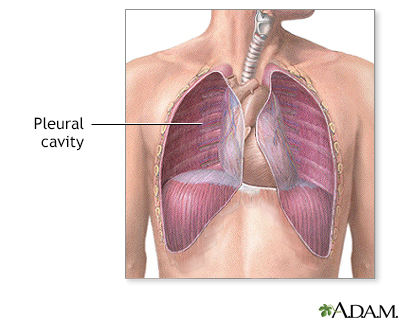Pregnancy SmartSiteTM
Fluid in the chest; Fluid on the lung; Pleural fluid DefinitionA pleural effusion is a buildup of fluid between the layers of tissue that line the lungs and chest cavity. CausesThe body produces pleural fluid in small amounts to lubricate the surfaces of the pleura. This is the thin tissue that lines the chest cavity and surrounds the lungs. Pleural effusion is an abnormal, excessive collection of this fluid. There are two types of pleural effusion:
Risk factors for pleural effusion may include:
SymptomsSymptoms can include any of the following:
Sometimes there are no symptoms. Exams and TestsYour health care provider will examine you and ask about your symptoms. The provider will also listen to your lungs with a stethoscope and tap (percuss) your chest and upper back. Chest CT scan or a chest x-ray may be enough for your provider to decide on treatment. Your provider may want to perform tests on the fluid. If so, a sample of fluid is removed with a needle inserted between the ribs. Tests on the fluid will be done to look for:
Blood tests that may be done include:
If needed, these other tests may be done:
TreatmentThe goal of treatment is to:
Removing the fluid (thoracentesis) may be done if there is a lot of fluid and it is causing chest pressure, shortness of breath, or a low oxygen level. Removing the fluid allows the lung to expand, making breathing easier. The cause of the fluid buildup must also be treated:
In people with cancer or infection, the effusion is often treated by using a chest tube to drain the fluid and treating its cause. In some cases, any of the following treatments are done:
Outlook (Prognosis)The outcome depends on the underlying disease. Possible ComplicationsComplications of pleural effusion may include:
When to Contact a Medical ProfessionalContact your provider or go to the emergency room if you have:
ReferencesBlok BK. Thoracentesis. In: Roberts JR, Custalow CB, Thomsen TW, eds. Roberts and Hedges' Clinical Procedures in Emergency Medicine and Acute Care. 7th ed. Philadelphia, PA: Elsevier; 2019:chap 9. Broaddus VC, Light RW. Pleural effusion. In: Broaddus VC, Ernst JD, King TE, et al, eds. Murray and Nadel's Textbook of Respiratory Medicine. 7th ed. Philadelphia, PA: Elsevier; 2022:chap 108. McCool FD. Diseases of the diaphragm, chest wall, pleura and mediastinum. In: Goldman L, Schafer AI, eds. Goldman-Cecil Medicine. 26th ed. Philadelphia, PA: Elsevier; 2020:chap 92. | |
| |
Review Date: 7/31/2022 Reviewed By: Denis Hadjiliadis, MD, MHS, Paul F. Harron Jr. Professor of Medicine, Pulmonary, Allergy, and Critical Care, Perelman School of Medicine, University of Pennsylvania, Philadelphia, PA. Also reviewed by David C. Dugdale, MD, Medical Director, Brenda Conaway, Editorial Director, and the A.D.A.M. Editorial team. The information provided herein should not be used during any medical emergency or for the diagnosis or treatment of any medical condition. A licensed medical professional should be consulted for diagnosis and treatment of any and all medical conditions. Links to other sites are provided for information only -- they do not constitute endorsements of those other sites. No warranty of any kind, either expressed or implied, is made as to the accuracy, reliability, timeliness, or correctness of any translations made by a third-party service of the information provided herein into any other language. © 1997- A.D.A.M., a business unit of Ebix, Inc. Any duplication or distribution of the information contained herein is strictly prohibited. | |

 Lungs
Lungs Respiratory system
Respiratory system Pleural cavity
Pleural cavity
